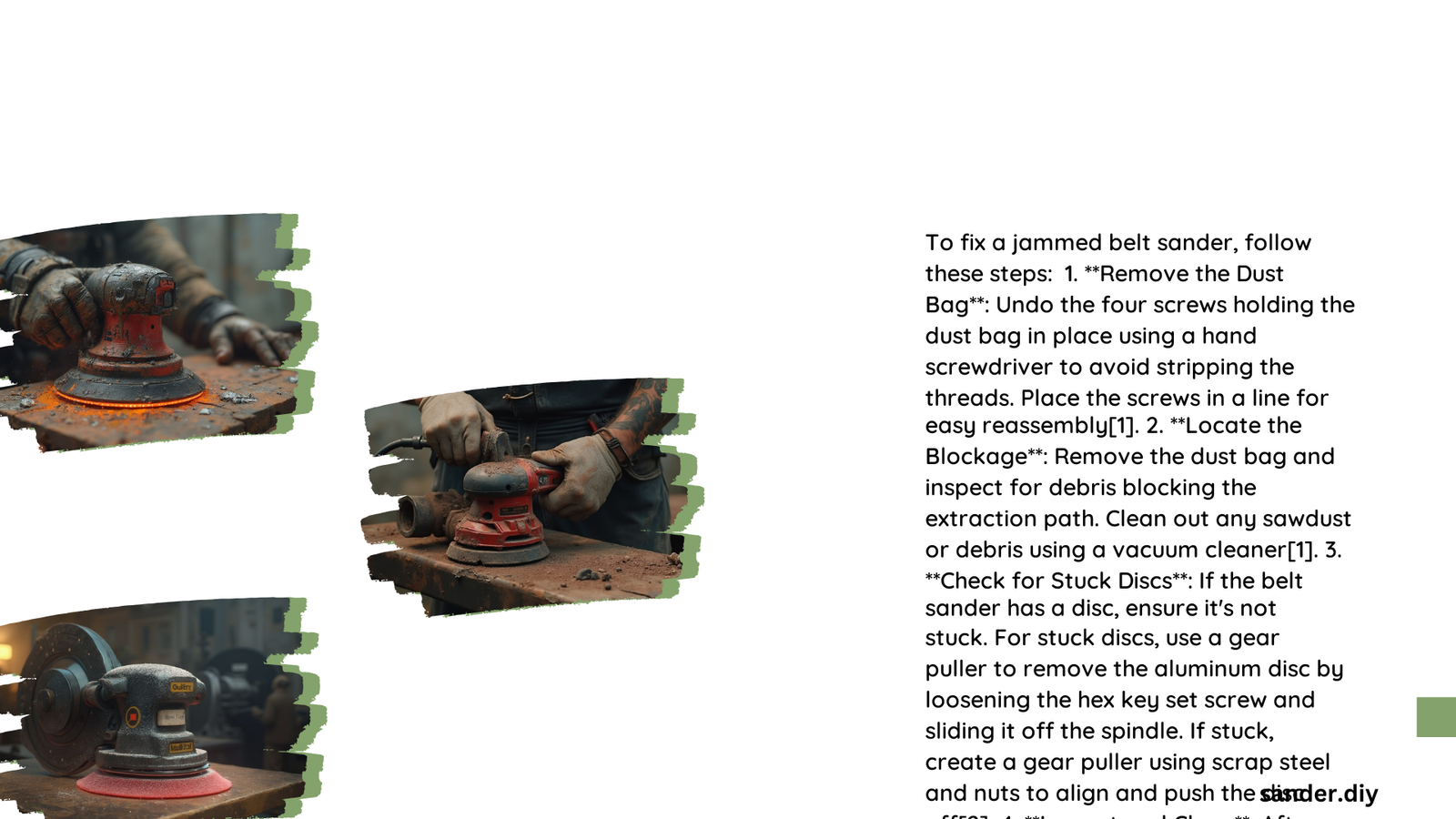A belt sander jammed is a common issue that can significantly impact productivity and workpiece quality. This problem often stems from improper belt tracking, overloading, or static electricity buildup. Understanding the causes and implementing effective solutions can help prevent belt sander jams, ensuring smooth operation and optimal performance. This comprehensive guide explores the root causes, troubleshooting steps, and preventive measures for belt sander jams.
What Are the Common Causes of a Belt Sander Jammed?
Belt sander jams can occur due to various reasons, each requiring specific attention and solutions:
-
Improper Belt Tracking: This is often the primary culprit behind belt sander jams. Incorrect tension pressure, obstructed laser eyes, or improperly cut belts can lead to tracking issues.
-
Overloading or Belt Burning: Excessive material removal or foreign particles can cause the belt to jam or break.
-
Static Electricity: Static buildup can cause dust to stick to the belt and machine components, leading to misalignment and jams.
-
Worn or Damaged Components: Deteriorated rollers, bearings, or other mechanical parts can contribute to belt sander jams.
How Can You Troubleshoot a Belt Sander Jammed?

Follow this step-by-step process to diagnose and resolve belt sander jams:
- Check Belt Tension:
- Use the following formula to calculate correct tension:
Tension Cylinder Area = π × Radius²
Abrasive Belt Tension = (Tension Cylinder Area × Gauge Pressure) / Belt Width - Adjust tension accordingly
-
Time estimate: 10-15 minutes
-
Clean the Laser Eye:
- Wipe the laser eye to remove dust and debris
-
Time estimate: 5 minutes
-
Inspect and Adjust Rollers:
- Use a digital indicator to measure roller parallelism
- Make necessary adjustments
-
Time estimate: 20-30 minutes
-
Check Belt Cut and Storage:
- Visually inspect the belt for proper cutting
- Ensure proper storage conditions
-
Time estimate: 5-10 minutes
-
Inspect Workpieces:
- Ensure workpieces are clean and uniform in thickness
-
Time estimate: 10-15 minutes
-
Address Static Electricity Issues:
- Look for signs of static buildup
- Ground the sander if necessary
- Time estimate: 15-30 minutes
What Are the Specifications for Compatible Belts?
When replacing a jammed belt, consider the following specifications:
| Specification | Description |
|---|---|
| Width | Match the sander’s requirements (e.g., 6 inches) |
| Length | Typically 37 inches for wide belt sanders |
| Grit | Varies based on the application |
| Material | Choose based on workpiece and desired finish |
How Much Do Replacement Belts Cost?
The cost of replacement belts can vary:
- High-quality wide belt sander belts: $20 to $50 or more
- Factors affecting cost:
- Belt size
- Grit
- Material quality
- Brand
What Is the Time Required for Belt Replacement?
Replacing a belt sander belt involves several steps:
- Removing the old belt: 10-15 minutes
- Installing the new belt: 10-15 minutes
- Adjusting tension and tracking: 15-30 minutes
Total estimated time: 35-60 minutes
How Can You Prevent Belt Sander Jams?
Implement these preventive measures to avoid future belt sander jams:
- Regular Maintenance:
- Clean the sander components regularly
- Inspect belts for wear and damage
-
Lubricate moving parts as recommended by the manufacturer
-
Proper Belt Storage:
- Hang belts to prevent moisture absorption and shape distortion
-
Store in a cool, dry place
-
Correct Tension Settings:
-
Use the provided formula to calculate and maintain proper tension
-
Workpiece Preparation:
- Ensure workpieces are clean and uniform in thickness
-
Remove any foreign objects or debris
-
Static Electricity Management:
- Ground the sander properly
-
Use anti-static sprays or devices if necessary
-
Operator Training:
- Educate operators on proper sander use and maintenance
- Teach troubleshooting techniques for quick problem resolution
By following these guidelines and implementing preventive measures, you can significantly reduce the occurrence of belt sander jams, improving productivity and workpiece quality.
What Are the Long-Term Benefits of Proper Belt Sander Maintenance?
Maintaining your belt sander properly offers several long-term advantages:
- Increased Lifespan: Regular maintenance extends the sander’s operational life.
- Consistent Performance: Well-maintained sanders provide consistent results.
- Cost Savings: Preventing jams and breakdowns reduces repair and replacement costs.
- Improved Safety: Properly functioning sanders are safer to operate.
- Enhanced Productivity: Fewer jams mean more time spent on actual work.
Implementing a comprehensive maintenance plan and addressing belt sander jams promptly can lead to significant improvements in your woodworking or metalworking operations.
References:
1. https://timesaversinc.com/blog/common-wide-belt-sander-problems
2. https://www.fintechabrasives.com/blog/fintech-blog-1/common-wide-belt-sander-issues-solutions-4
3. https://www.sandpaper.com/articles/why-and-how-to-properly-ground-your-wide-belt-sander/
